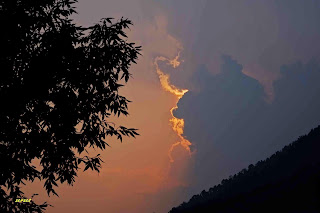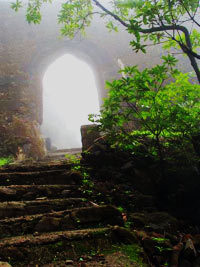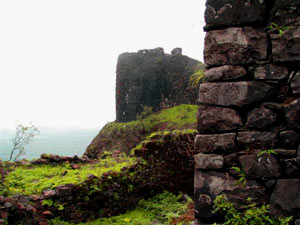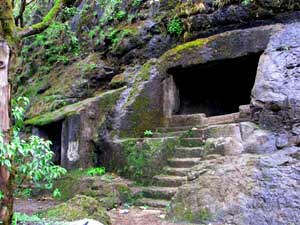In 1987 the Indian
Peace Keeping Force (IPKF) was deployed in Sri
Lanka to underwrite the Sri Lanka
The helicopter blades stuttered as the ancient MI-8 came in to land at
Mullaitivu, on the northeast coast of Sri Lanka . It was spectacular.
Close to shore, where the seabed dropped sharp and deep, blue water shaded to
green before hitting the stark white sands of the beach. At the mouth of a
shallow lagoon lay the quiet fishing hamlet of Mullaitivu, flanked with rice
paddies where in the rains crocodiles basked in the sun on the raised bunds. An
idyllic holiday destination, I thought. I had arrived in the Emerald Isle, once
called Serendip. But this was June 1988. There was no serendipity left, and the
‘P’ had long dropped out of the IPKF. India was at war with the LTTE.
The rear doors of the helicopter had been removed, so the feet of the
Para Commandos sitting in the back dangled in space, and mine almost touched
the palm trees. The downwash whipped the fronds into frenzy as the huge chopper
touched down in a cloud of dust. The Paras had been impatient about having to
pick me up at the divisional HQ at Vavuniya, barely waiting for me to buckle my
seat belt before taking off, and now my luggage and I were just as
unceremoniously ejected on to a desolate helipad.
As the helicopter receded into the distance, I surveyed what were to be
my headquarters, office and home for the next two years. Before me was a
kaleidoscope of war and peace: combat-ready soldiers amid swaying palms,
camouflaged bunkers between tiled huts.
My journey had involved a train to Tambaram, an AN-32 cargo aircraft to
Vavuniya on the east coast, and finally a helicopter ride to my brigade
location at Mullaitivu—and that was the fast track. I was often told of soldiers
going to and from their operational areas on the island travelling for up to a
month and a half. Troops had been specifically deployed to open roads so that
soldiers could travel in convoys to Trincomalee
Port , board ship to transit camps in Madras , and from there
take regular trains home. It was not uncommon for a homebound convoy to be
ambushed by the LTTE, or diverted by military headquarters to some other
critical battle location to make up a shortfall of troops. Sometimes it was
months before a soldier could complete his journey.
I had just graduated from the Defence
Services Staff
College at Wellington ,
in Tamil Nadu and had been assigned as Brigade Major (BM) of a brigade in the
thick of the fighting in Sri
Lanka . Brimming with arcane military
knowledge and trivia I was let loose on an unsuspecting Army and expected to
try my newfound theoretical skills in the reality of war. Worse, I was an armoured
corps officer at a time when there weren’t many ‘cavaliers’, as we called
ourselves, deployed in counterinsurgency operations anywhere in the Indian
Army. The armoured corps had an unfortunate (and undeserved) reputation for
being too fashionable and cavalier, pun intended, about serious military
matters. When I arrived at Vavuniya, attired in a fresh combat dress and hair
cut efficiently short, a crusty infantry colonel eyed me up and down and said
“So, Mr. Armoured Corps, where is your long hair now?” To this I retorted,
somewhat defensively, that my long hair would be manifest in my work. I must
have proved myself, for we later became good friends.
The Brigade HQ was located in a cluster of tiled huts on the outskirts
of Mullaitiviu. This extraordinarily beautiful village had become the
war-ravaged heart of LTTE activity. We had hired the picturesque tiled huts for
residences, offices, stores and perimeter defences—which were particularly
important against the odd LTTE cadre who, when he had nothing else to do, would
sit in the nearby jungle and snipe at us. This ‘stand off firing’ was common: LTTE
cadres would come within a few hundred metres of our camp, fire a few bursts
from an AK and disappear into the deep forest or into the blue sea. If our troops
were not well trained they would open up with all the weapons they had,
creating a self-generated frenzy—the more fire we heard, the more we assumed a
large attack, and the more we fired indiscriminately, often into the early
hours of the morning. We had many dead shadows to our credit in this sort of
action.
We overreacted to stand off firing frequently in the early days, before
we wised up to the LTTE’s tactics. I recollect my first evening in Mullavaitu when
there was such a fierce firestorm that I thought it the beginning of my end. A
few battle-weary weeks later, attuned like a well-trained musician to the
differences in tone of fire of various weapons, I would just turn over in my
sleep if I did not hear the bang of LTTE weapons.
Combat on the island was unlike anything the Indian Army had experienced
until then, especially me. I had commanded a tank squadron in the wide open
spaces of the Rajasthan desert, and Sri Lanka ’s dense jungles and
intense close quarter combat served up a stark reality check. Most military
units inducted for operations in Sri Lanka were from formations
trained for conventional warfare, so until we re-orientated ourselves and
evolved new fighting methods, we suffered heavy casualties. We very quickly
found out that we were not fighting some local tribe armed with country-made
weapons.
It was here that our troops experienced the close-range devastation of
an AK-47 in the jungle for perhaps the first time; few of us can forget the
chilling rip of an AK fired at close quarters. Our venerable but ancient 7.62mm
Self Loading Rifle (SLR), which delivered an aimed single shot, was no match for
enemy automatics ripping at 600 rounds per minute. It took time to suitably
equip our troops against the deadly AK-47. Until we began getting AK-47s
through Ordnance channels, units retained captured LTTE weapons or tried out
various (mostly unsuccessful) modifications on existing Indian Army weapons.
Contact with the LTTE typically lasted a few seconds or minutes at the
most, just enough time for them to fire two AK-47 magazines, snatch the weapons
of dead or wounded Indian soldiers, and run away in the confusion. It was a
while before our troops acclimatized to this form of hit-and-run fighting. Young
Captain Rao* from the Sikh Battalion described his first contact thus. He was commanding a small party detailed to go
and fetch water from a nearby well located outside the camp. This had become a
routine activity to keep the post in sweet water. Unknown to him the LTTE had
kept the camp under surveillance and had picked up the regular pattern of the
water patrol. They laid an ambush. It was a hot and humid day; the jungle was
absolutely silent save for the sound of insects and the faint rustle of leaves as
animals made their way through the undergrowth. Nervously hitching up his ill
fitting helmet Rao scanned the foliage , every leaf moving was a potential
enemy, heaving a tentative sigh of relief they were about to reach the well
when suddenly the undergrowth exploded in a blaze of AK-47 fire. In the first shattering volley the two
leading scouts ahead of Captain Rao were killed and the LTTE sallied forth to grab
their weapons. This young officer opened
intense fire at the LTTE more out of self preservation than valour, thinking if
the LTTE came any closer they would get him too. In doing so he killed one of the attackers
and the rest withdrew, he managed to save the situation. It all lasted less than 30 to 40
seconds. The ensuing silence was deafening,
punctuated by the receding rustle and drag of the LTTE running away with their
wounded.
The Sri Lanka
experience brought home to me the stark fact that true bravery emerges in
adverse situations and that the Indian Army seldom gives medals to those who
emerge from adverse battles. The heroism of Captain Gupta is a telling case in
point. In normal times this mild looking
officer from the Army Medical Corps would hardly appear to be a hero in battle.
He was the doctor with a Gurkha battalion involved in a cordon and search
operation. Hitting a larger than
anticipated LTTE camp in dense jungle, the Gurkhas was involved in a running
gun fight over two days, the desperate LTTE obviously guarding a senior leader
brought everything they had to bear on the relatively small patrol. The then
inexperienced Gurkhas were badly mauled by the violence of the LTTE reaction. Many
were dead or wounded, and in the dense jungle with night fast approaching the
men were in extreme disarray. There were no fronts and the firing was from all
directions between friend and foe. In
this melee and under continuous fire, the seemingly mild army doctor gathered
the wounded and tended to them. In the
confusion of the fighting he soon found himself alone with the wounded. Carbine in hand he began looking for fit men
of his battalion to help him carry the wounded out of the jungle. Sensing reluctance
from some of these men to go back, he marshaled them at gun point and forced
them to carry the wounded out of the dense forest. The next morning witnesses saw him emerge from
the forest shepherding his party at gunpoint. For a whole night he had stayed at
the rear, fending off harrying LTTE attacks, until he’d evacuated all the
wounded. I do not recall him getting a gallantry medal.
‘Jungle bashing’, as patrolling or cordon and search was known, was the
primary operation and became an art form; most units graduated from this harsh
school as experts in jungle warfare. It was arduous and perilous work. Captain Sharma of the Garhwal battalion once
described to me the pattern of a typical operation. He lead a patrol from his post self contained for 48 to 72
hours, this meant all food, water, weapon, ammunition and communication was
carried on one’s person, a load of 20 to 30 kilograms . Usually the patrol was
tasked to search an area or lay an ambush on a known LTTE route. The patrol could not follow trails in the
dense jungle as most trails were mined by the LTTE. Hence the patrol had to
forge its way through dense vegetation that was constantly wet and where the
visibility was often less than 5 meters.
It was an excruciatingly slow and mind numbing operation, with dense
jungle, leeches, constant humidity, sores from chaffing of equipment and
clothes on wet skin, stale food and lack of drinking water adding to the
tribulations of combat. Hours of monotony and battling with the discomfort
tended to lull a soldier into a false sense of “nothing is happening” thus
contact with the LTTE, when it came, required immediate reorientation to the
direction of enemy fire. The contact was
a blaze of fire that was over in minutes if not seconds. Ranges were so short
that invariably there were casualties on both sides and after the contact there
was the heart rending task of evacuating the wounded. Casualty evacuation
(casevac) had to be by helicopter as a seriously wounded soldier seldom
survived being carried for 12 hours or more on a stretcher. The stark reality
of the ‘Golden Hour’ was driven home harshly; a wounded soldier receiving
medical attention in the first hour stood the best chance of survival. Helicopters were not allowed to fly
operational or casevac missions after sunset so if you were wounded near sunset
God had to be on your side to survive the night.
Troops were out for days and sometimes even weeks in the jungle in
constant rain and high humidity. I have
seen soldiers emerge from the jungle with their clothes completely
disintegrating due to the moisture and wear in the jungle. The lack of importance given to this war or
maybe plain ignorance of what was happening was apparent in the CAG’s audit
objection “what is the need for the soldiers in the IPKF to be issued an extra
combat dress” or words to that effect. Units
that did not adapt fast enough to this style of combat were quickly identified
and targeted by the enemy. The LTTE was very casualty-sensitive in the early
days and appeared to avoid contact with capable and professional units, but relentlessly
harassed units they perceived as weak or incapable. In most cases the officers—the
commanding officer in particular—made or broke a unit’s performance. Our troops
are uniformly competent and intrepid; officer leadership makes the
difference.
Our young officers were the steel spine of the fighting. Small unit
operations and small teams led by young officers were always at the cutting
edge of battle. These officers had a swashbuckling, devil-may-care sense of
adventure and almost always performed in an exemplary manner. I remember the
incident of a young short service commission officer, Major Negi of the Garwhal
battalion. For the short time that I had the privilege of knowing him, he was
always in the middle of the fighting, never letting up. When his contract with
the Army expired, he was not granted a permanent commission, ostensibly because
he was not good enough. Others of his unit told me that during peace time this
boy was perpetually in trouble but his men adored him. The day his term expired
we sent a helicopter to pick him up for de-induction and repatriation. When he
saw the chopper he disappeared into the jungle with his men because, as he said,
he “was having too much fun”. This sense of “fun” is a battle-winning factor,
and too little has been said about these brave young men who are the backbone
of our army in every conflict. Unfortunately this spirit dims as career
considerations take hold, and the tendency to play safe and pass the decision-making
buck increases. It also makes one think that are we destroying the offensive
spirit of our youngsters by forcing them to toe a docile and submissive career line? After all if you breed sheep in peace you
cannot expect them to become tigers in war.
It was here, on the Emerald Isle, that the dreaded word ‘IED”
(Improvised Explosive Device) entered the Indian military lexicon. The LTTE
were expert at this particularly deadly form of warfare and we suffered most of
our casualties due to mines. It took a lot of training and equipping to find effective
countermeasures. A particularly daring and competent young Engineer officer I
knew suffered a splinter embedded near his heart by an IED explosion. He
survived; but many other less fortunate men lost lives or limbs. The savagery
of a mine attack is illustrated by an incident that haunts me even today. We were camping in the jungle during a
particular operation and the LTTE had observed the route taken by a particular
soldier each morning when he went to perform his essential ablutions. One day
they placed a small anti-personnel mine on the path. This mine blew off a part of the soldier’s
foot, his screams echo in my mind to this day. By the way anti-personnel mines
are designed to maim not kill, the logic being that a maimed person is a
logistic burden and adversely affects the morale of others also. This
particularly vicious form of warfare was totally one-sided—the Indian Army was
not allowed to lay mines.
The LTTE were remarkably adept at improvisation, and used this ability
to deadly effect. What they could not buy, they made. I recall seeing
improvised bombs, homemade mortars and mortar ammunition, grenades, and of
course the ubiquitous IED in its myriad forms, from the tiny anti-personnel
mine to the large claymore. I later heard that the LTTE had tried to make an
aircraft, and even a submarine.
The only Indian Army helicopter to be destroyed in enemy action on the
Island was at the tactical HQ of the Brigade of which I was the Brigade Major.
A very senior officer and his entourage had made a temporary helipad out of a kulam,
or lake bed, in the forest close to our HQ. The LTTE observed a pattern of
regular landings here, and one day attacked with an elite suicide squad of
three five-man groups. These cadres were well armed with an American LAW (light
anti-tank weapon) and two 52mm mortars, besides the ubiquitous AK. A single
shot from the LAW hit one of four parked helicopters and destroyed it
completely, and then they opened intense fire. Luckily we were able to repulse
the ambush before more damage was done.
My radio operator and I became the target of a storm of LTTE fire as they
tried to take out our communications. There
were humorous interludes even at the height of action such as this. My radio operator tells me “Sahib protect
your head, it is easy to take a bullet out of your leg, but impossible if you
are hit in the head”.
In 1989 and early 1990 it became clear that India was washing its hands of what
it perceived to be a military debacle. By 1989 President Premdasa had an
election manifesto of withdrawal of the IPKF, besides he began treating with
the LTTE who also felt the pressure of the IPKF. I suspect, even the Indian political and
military hierarchy began believing that they were not wanted in Sri Lanka there
was no end to this conflict in sight. A “withdrawal” was ordered and troops
began leaving. National politics apart, we
could see the government’s apathy towards the soldiers of the IPKF in many ways
big and small—lack of amenities while serving in this harsh environment,
reduced allowances for troops, limited compensation to battle casualties, and
so on.
A small but significant incident demonstrating the lack of honour given
to de-inducting units has stayed with me. The first units to go in began
de-inducting after one or two years of hard fighting and with many comrades
dead or wounded. The orders from the Government were that these units would be
ceremonially and publicly honoured by senior Army officers on their arrival at
Madras Port, and presented with an IPKF flag as a mark of recognition of their
having fought in this arduous war. This direction became so diluted with
each deinduction that by the time we de-inducted in January 1990, we were met
by a junior duty officer from some local unit, who came to the jetty, furtively
handed us the flag and left. The IPKF finally left the Island
in March 1990.
In the years since the Sri
Lanka war, I have kept in touch with many of
the officers and men I was privileged to serve alongside in combat. All of them
were affected by this experience, most of them positively. Units that fought
here went on to successfully fight counterinsurgency elsewhere in the country,
battle-hardened and wiser to the ways of this peculiar form of combat. In the
end, serving in Sri Lanka
did what combat invariably does: cemented deep bonds of comradeship amongst
those who were there.
Compared with the other wars and insurgencies The Indian Army has fought
since there were many more casualties in the IPKF, by official estimates about
1100 to 1200 died in this war, the wounded would be many times that. The Kargil
war, by comparison, had just over 400 killed but was made so much more of. Many
believed that the nation had lost the war in Sri Lanka , so there is little
mention of it. The fact that government blacked
out the media, in sharp contrast to Kargil, doesn’t help. I think the words commonly
used of the “IPKF withdrawal” summed up the national psyche at the time. Unsung
heroes of an unsung war.
* Whereas these are actual incidents, the names of persons and units
involved have been changed to protect identities.








%2Be.jpg)








.JPG)


















